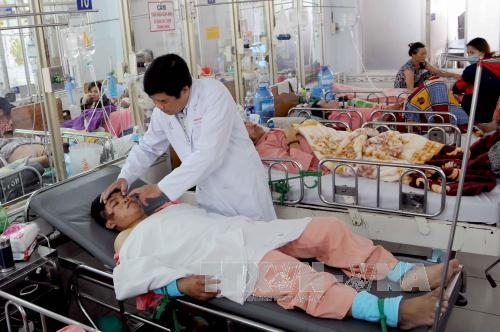 Society
Society

The implementation of nutritional practices in hospitals is still a neglected issue although it is vital in significantly reducing mortality in critically ill patients, experts have said.
 |
| Patients in the Emergency Department of Chợ Rẫy Hospital in HCM City. — Photo An Hiếu |
HCM CITY— The implementation of nutritional practices in hospitals is still a neglected issue although it is vital in significantly reducing mortality in critically ill patients, experts have said.
The prevalence of malnutrition among hospitalised patients ranges from 43-50 per cent, said Dr Lưu Ngân Tâm, head of the HCM City Society of Parenteral Enteral Nutrition.
Malnutrition increases the mortality rate, length of stay and treatment costs, according to Tâm.
Nutrition support includes enteral nutrition and parenteral nutrition, she said at a conference on nutrition management to enhance treatment quality held last week in HCM City.
Early enteral nutrition, provided within 24 hours of injury or intensive care unit (ICU) admission, significantly reduces mortality in critically ill patients, said Prof. Rémy Meier, hepatology and nutrition specialist from Switzerland’s University of Basel.
“Enteral nutrition should be started as soon as possible. Excessive and insufficient calorie intakes are deleterious in ICU patients,” he said. “Energy and protein deficits are associated with morbidity and mortality. It is important for optimal energy and protein homeostasis.”
A worldwide survey showed that calorie and protein administration reached only 44-52 per cent of the prescribed amount.
Overall enteral nutrition is more beneficial than parenteral nutrition alone. When enteral nutrition does not meet 60 per cent of nutritional needs, parenteral nutrition should be added.
Dr. Tạ Thị Tuyết Mai, head of Gia Định People Hospital’s Nutrition Department, said that most hospitals in Việt Nam failed to offer appropriate nutrition support to patients.
Nutrition screening and support meets only 0.5 per cent of the demand among hospitalised patients at Gia Định People Hospital, Mai said.
She blamed the inappropriate nutritional risk screening and nutrition support on a lack of nutritional practice knowledge among doctors and nurses as well as hospital overloading.
The hospital has 1,500 beds, but it serves 3,000 out-patients and 1,500 in-patients every day.
The annual conference organised by the HCM City Society of Parenteral Enteral Nutrition in coordination with Chợ Rẫy Hospital attracted more than 300 domestic and international experts and doctors.
Topics under discussion included mutrition assessment on hospitalised patients, optimal nutritional strategy in critically ill patients, nutrition care in chronic pancreatitis, and nutritional therapy in GI failure. —VNS









